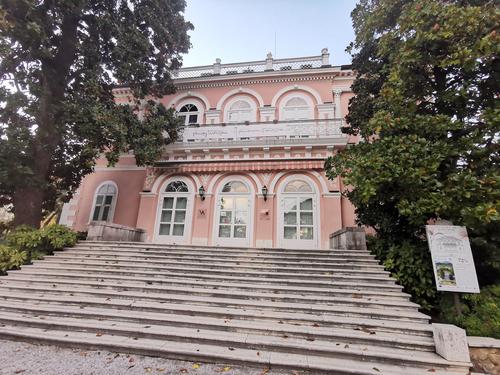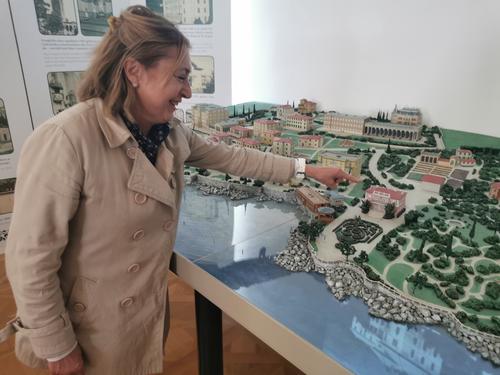Report of a Visit to the Croatian Tourism Museum
Villa Angiolina. The site of the Croatian Museum of Tourism
The director of the museum, Dr. Mirjana Koš, demonstrates the development of the spa town at the model
News from Oct 19, 2021
On the Challenges of Maintaining and Revivifying Historical Heritage. Report of a Visit to our Associated Partner, the Croatian Tourism Museum
The person who undertook the visit to our Associated Partner, the Croatian Tourism Museum in Opatija - also known as Abbazia (in Italian) and Sankt Jakobus (in German) - the historic seaside resort and climatic spa on the Adriatic Sea, was team member Henrike Schmidt. The winter health resort has a long history dating back to the late 19th century and is closely linked to Habsburg rule in the region. Known as the Austrian Riviera, this part of the Adriatic coast enjoyed considerable renown. The Emperor Franz Joseph I and numerous members of the ruling family, as well as many representatives of the Austro-Hungarian bourgeoisie, visited the seaside resort, which was and still is famous for its mild winter climate. Emperor Franz Joseph was also responsible for the construction of the 12-kilometer Lungomare scenic path along the coast, from the fashionable seaside resort to the nearby former fishing villages of Lovran and Volosko.
The director of the Croatian Museum of Tourism, Dr. Mirjana Koš, introduced the visitor from the European Spa Team to the special history of the place, but also of the building in which the museum itself is located. This is Villa Angiolina, the nucleus of the small town's development into a tourism hotspot: for it was here, in 1844, that the merchant Iginio Scarpa from nearby Rijeka created his summer residence, which was soon to become the focal point of society and the starting point of the region's tourism development.
On the basis of a historical model, Mirjana Koš explains the further development of the town, which is typically associated with the connection to the European railroad networks, in this case the Austrian Southern Railway, which connects the resort, or rather the nearby town of Matulji, with the capital of the Dual Monarchy, Vienna. In addition to transporting guests, the railroad company also started to build the first hotels, a lucrative business. Among the first of the fashionable hotels founded during this period was the Hotel Kvarner with its legendary Hall of Mirrors. Many of these historic places and buildings are still preserved today. The Southern Railway Company has been replaced these days by the hotel chain Liburnia, which manages a large number of the historic hotels and villas from Habsburg, but also Yugoslavian times.
Of course, Opatija has also had its share of famous guests. As a Slavist scholar, Henrike Schmidt was interested to follow the traces of the Russians during her stay: Anton Chekhov, it traspires, stayed not only in Yalta, to whose spa myth he contributed significantly, and in Badenweiler, where he died too early. He also visited Opatija, which he however found rather unattractive and boring due to the bad weather (well, he also found his quasi-second place of residence, Yalta, boring). Chekhov's mood was as capricious as the often changing weather in Opatija, noted museum director Mirjana Koš with an ironic smile. Vladimir Nabokov stayed at the Imperial Hotel, which still exists today, while Sergei Esenin and his lover, the dancer Isadora Duncan, preferred the accommodation in the Villa Amalia. The palm tree in front of the house, its leaves swaying in the wind, is said to have inspired the dancer in her famous expressive dance.
The First World War was also a turning point for Opatija and marked the end of the so-called golden era. This was followed by about twenty years under Italian rule and, after the Second World War, by integration into the newly created Socialist Federal Republic of Yugoslavia. The stately villas and hotels were nationalized. New hotels and sanatoriums in modernist style were built. The traces of this period are less loved in the city and also less present in the museum.
Mirjana Koš and Henrike Schmidt talked at the meeting about future joint activities of the Museum of Tourism History and the European Spa Project, such as a joint exhibition on the theme of Croatian spas in European contexts planned for June 2022. But the topics discussed are also included the challenges of preserving an outstanding cultural heritage, given the changes in tourism and healthcare, the needs of the local population and the wishes of guests. How can the specific features of a climatic winter resort, which Opatija historically represents, be fitted into today's travel and tourism landscape? How can the historical architectural heritage of the Habsburg era be preserved and reconciled with the remnants of Yugoslav modernity? How can a sufficient tourist - and balneological - infrastructure be created without the place losing its local population and becoming a spa museum? The Croatian Museum of Tourism is a highly appropriate - and certainly very beautiful - place to reflect on these questions.


